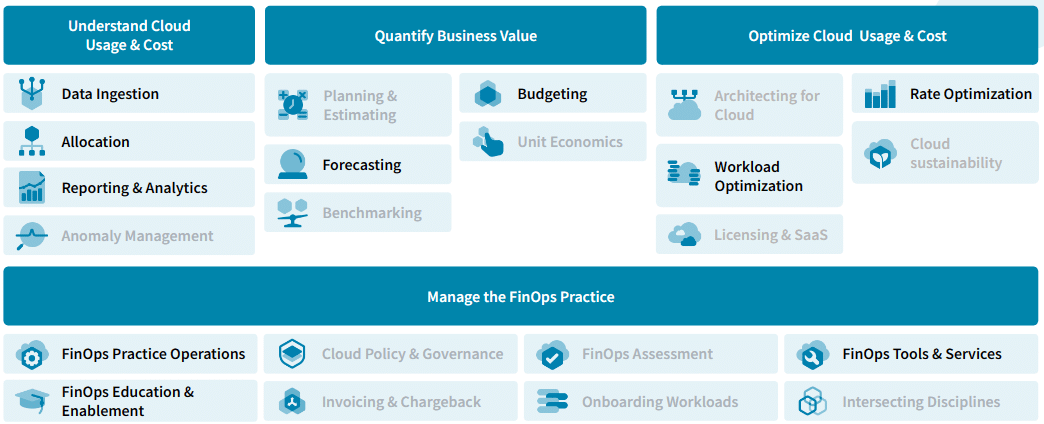In my blog series, you’ve learned how to optimize your cloud costs. This final and most important step focuses on making optimization a habit — whether daily or at least weekly. FinOps can help you achieve this.
FinOps, short for Financial Operations, is a framework designed to help organizations optimize their cloud spending. It follows a continuous cycle of “Inform, Optimize, Operate”. In this post, we’ll dive into how to implement FinOps in your organization and achieve significant cost savings.
Why FinOps? A Customer Scenario
The cloud keeps growing, and so do costs, but often no one knows exactly why or whether the additional expenses bring value. Without a structured approach, you risk falling into common traps like unused resources and lack of transparency. These challenges lead to unnecessary costs and budget overruns.
By implementing FinOps, you can gain visibility into your cloud spending, identify opportunities to save, and continuously optimize how you use the cloud.
How to Implement FinOps
 FinOps capabilities to optimize your cloud costs. Source: FinOps Foundation
FinOps capabilities to optimize your cloud costs. Source: FinOps Foundation
In earlier posts, I introduced you to various operational measures for cost optimization. FinOps helps establish the processes and organizational changes needed for sustainable cost management. To implement FinOps, follow these stages:
- Research: Gather information on current cloud spending, usage patterns, and stakeholder needs to build a case for FinOps.
- Propose: Present the benefits of FinOps to stakeholders and gain approval for adoption.
- Prepare: Create a roadmap, establish a FinOps team, and define processes.
- Launch: Officially start your FinOps practice, implement processes, and continuously improve.
For example, when dealing with commitments, start small and expand over time. Purchasing too many commitments at once can lead to unused resources, especially if workloads change. By iterating through the FinOps cycle, you can optimize your spending step by step.
The FinOps Cycle: Inform, Optimize, Operate
FinOps relies on a cycle of three key phases that you iterate through continuously.
Inform
The first step is to create transparency around cloud costs by gathering and analyzing data. This includes:
- Collecting data from various sources
- Creating dashboards and reports
- Setting up alerts for budget anomalies
Optimize
In this phase, focus on identifying and implementing cost-saving measures, such as:
- Identifying cost drivers
- Rightsizing resources
- Eliminating cloud waste
- Using commitments like Reserved Instances and Savings Plans
Operate
The final phase is about continuously monitoring and refining your strategies to maintain cost efficiency. This involves:
- Implementing monitoring tools
- Regularly reviewing and adjusting optimization efforts
- Collaborating with teams to ensure ongoing cost management
Maturing Over Time
As shown in the image above, FinOps consists of almost two dozen capabilities. When starting, focus on the areas that are not grayed out. Over time, as your organization matures in its FinOps practices, you can implement the remaining capabilities.
Other Posts in the Cost Optimization Series
- Azure Cost Optimization Part 0 - Are you paying too much for your cloud?
- Azure Cost Optimization Part 1 - Know your costs
- Azure Cost Optimization Part 2 - Stay alert
- Azure Cost Optimization Part 3 - Identify cloud waste
- Azure Cost Optimization Part 4 - Rightsize your resources
- Azure Cost Optimization Part 5 - Turn off if not needed
- Azure Cost Optimization Part 6 - Start small with commitments
- Azure Cost Optimization Part 7 - Bring cloud cost optimization into your organization
Conclusion
Optimizing cloud costs is not a one-time project; it’s an ongoing process. FinOps provides the structure and tools to make this process sustainable. By iterating through the cycle of Inform, Optimize, and Operate, you can consistently find new ways to reduce costs and improve efficiency.
Taking small, iterative steps — whether with commitments or other measures — helps you avoid costly mistakes and achieve long-term savings. Make optimization part of your routine, and you’ll see the benefits quickly.
Happy Optimization!